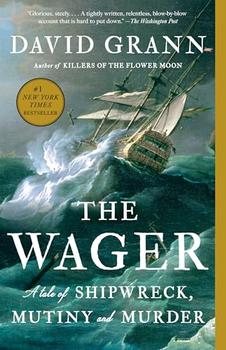Summary | Excerpt | Reading Guide | Reviews | Beyond the Book | Readalikes | Genres & Themes | Author Bio

A Tale of Shipwreck, Mutiny and Murder
by David Grann
British authorities soon devised a plan to launch an attack on a hub of Spain's colonial wealth: Cartagena. A South American city on the Caribbean, it was where much of the silver extracted from Peruvian mines was shipped in armed convoys to Spain. The British offensive—involving a massive fleet of 186 ships, led by Admiral Edward Vernon—would be the largest amphibious assault in history. But there was also another, much smaller operation: the one assigned to Commodore Anson.
With five warships and a scouting sloop, he and some two thousand men would sail across the Atlantic and round Cape Horn, "taking, sinking, burning, or otherwise destroying" enemy ships and weakening Spanish holdings from the Pacific coast of South America to the Philippines. The British government, in concocting its scheme, wanted to avoid the impression that it was merely sponsoring piracy. Yet the heart of the plan called for an act of outright thievery: to snatch a Spanish galleon loaded with virgin silver and hundreds of thousands of silver coins. Twice a year, Spain sent such a galleon—it was not always the same ship—from Mexico to the Philippines to purchase silks and spices and other Asian commodities, which, in turn, were sold in Europe and the Americas. These exchanges provided crucial links in Spain's global trading empire.
Cheap and the others ordered to carry out the mission were rarely privy to the agendas of those in power, but they were lured by a tantalizing prospect: a share of the treasure. The Centurion's twenty-two-year-old chaplain, Reverend Richard Walter, who later compiled an account of the voyage, described the galleon as "the most desirable prize that was to be met with in any part of the globe."
If Anson and his men prevailed—"if it shall please God to bless our arms," as the Admiralty put it—they would continue circling the earth before returning home. The Admiralty had given Anson a code and a cipher to use for his written communication, and an official warned that the mission must be carried out in the "most secret, expeditious manner." Otherwise, Anson's squadron might be intercepted and destroyed by a large Spanish armada being assembled under the command of Don José Pizarro.
Cheap was facing his longest expedition—he might be gone for three years—and his most perilous. But he saw himself as a knight-errant of the sea in search of "the greatest prize of all the oceans." And along the way, he might become a captain yet.
Yet if the squadron didn't embark quickly, Cheap feared, the entire party would be annihilated by a force even more dangerous than the Spanish armada: the violent seas around Cape Horn. Only a few British sailors had successfully made this passage, where winds routinely blow at gale force, waves can climb to nearly a hundred feet, and icebergs lurk in the hollows. Seamen thought that the best chance to survive was during the austral summer, between December and February. Reverend Walter cited this "essential maxim," explaining that during winter not only were the seas fiercer and the temperatures freezing; there were fewer hours of daylight in which one could discern the uncharted coastline. All these reasons, he argued, would make navigating around this unknown shore the "most dismaying and terrible."
But since war had been declared, in October 1739, the Centurion and the other men-of-war in the squadron—including the Gloucester, the Pearl, and the Severn—had been marooned in England, waiting to be repaired and fitted out for the next journey. Cheap watched helplessly as the days ticked by. January 1740 came and went. Then February and March. It was nearly half a year since the war with Spain had been declared; still, the squadron was not ready to sail.
It should have been an imposing force. Men-of-war were among the most sophisticated machines yet conceived: buoyant wooden castles powered across oceans by wind and sail. Reflecting the dual nature of their creators, they were devised to be both murderous instruments and the homes in which hundreds of sailors lived together as a family. In a lethal, floating chess game, these pieces were deployed around the globe to achieve what Sir Walter Raleigh had envisioned: "Whosoever commands the seas commands the trade of the world; whosoever commands the trade of the world commands the riches of the world."
Excerpted from The Wager by David Grann. Copyright © 2023 by David Grann. All rights reserved. No part of this excerpt may be reproduced or reprinted without permission in writing from the publisher.
Your guide toexceptional books
BookBrowse seeks out and recommends the best in contemporary fiction and nonfiction—books that not only engage and entertain but also deepen our understanding of ourselves and the world around us.